The Facebook algorithm often feels like a mystery, doesn’t it?
And as a result, brands are rightfully concerned about their presence on the platform.
Even if you haven’t been impacted by the recent algorithm changes yourself, you’ve probably heard horror stories of brands watching their organic reach take a nose-dive.
But Facebook algorithm changes don’t necessarily signal trouble for brands.
Not by a long shot, actually. According to the 2019 Sprout Social Index, Facebook is still the number one platform for marketers and consumers alike.
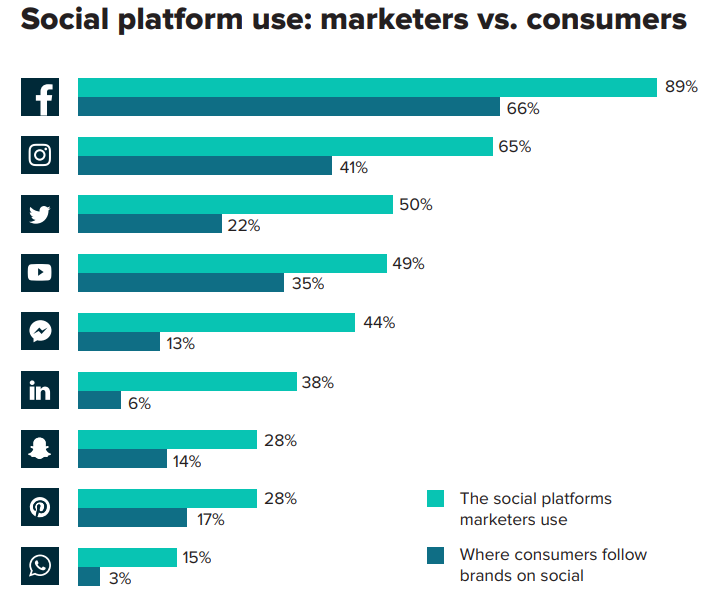
Recent Facebook stats also note that the platform produces one of the best ROIs for marketers when it comes to social ads. Given that your customers are already on Facebook, there’s every reason for you to be there, too.
The reality? Surviving the new Facebook algorithm means making some changes to your content strategy in order to bolster your organic reach.
How does the Facebook algorithm work these days?
The Facebook algorithm controls the ordering and presentation of posts, so users see what is most relevant to them.
Rather than publish content chronologically, posts and ads are presented based on what Facebook sees as relevant to you, the user.
Each time there’s a change to Facebook’s methodology, marketers tend to panic.
The most significant, sweeping change occurred in early 2018 when Facebook announced its pushback against branded content which left many businesses sweating. In a moment of transparency from Mark Zuckerberg himself, Facebook seemingly laid down the gauntlet against marketers and brands at large.
The 2018 update to the Facebook algorithm was designed to center content around individuals’ friends and family members, rather than prioritizing spam from businesses. This put legitimate companies and brands in a bind as they have had to adapt their Facebook marketing strategies accordingly.
Facebook algorithm 2019 changes and milestones
Fast forward to present-day and the Facebook algorithm is still evolving. Below is a quick snapshot of some of the changes Facebook has made in 2019.
“Why am I seeing this post?” update
As of March 2019, Facebook now provides context to why users see certain organic posts and ads. This further signals the need for brands to hone in their audience targeting and encourage interactions from followers.

The ongoing fight against misinformation
Facebook’s fight against “fake news” and misleading content is well-documented. In April 2019, Facebook elaborated on its manual efforts to fact-check content to fight misinformation.
This may not seem to impact brands directly but does highlight the importance of trust and transparency on the platform. Anything perceived to be needlessly controversial or spammy could quickly earn you a strike, so to speak.
Surveys to make feeds more personal
Personalization and relevant content remain a top priority of the Facebook algorithm. In May 2019, Facebook announced the widespread use of surveys to gather feedback from users to ensure they were seeing relevant content.
In terms of how business Pages were potentially impacted, here’s what Facebook had to say:
“These changes aren’t meant to show more or less from Pages or friends. Rather, the Page links that are surfaced to people will be ones they find worth their time — and the friend posts will be from friends people want to hear from most.”
The takeaway from these efforts is that “likes,” comments and any other form of engagement are all valuable currency for brands who want to be seen as relevant to their followers.
9 strategies for adapting to (and outsmarting) the Facebook algorithm
These ongoing changes all point to how the Facebook algorithm forces brands to roll with the punches and adapt.
This might be daunting but it shouldn’t diminish Facebook’s importance to your social efforts.
As part of the new algorithm’s goal of driving more authentic interactions, brands are expected to promote quality content that drives real interactions and shares.
How do you make it happen, though? Below are nine actionable strategies to keep your brand in the Facebook algorithm’s good graces.
1. Make video a cornerstone of your content strategy
You’ve heard it a million times before and we’ll say it again: it’s now or never for marketers to hop on the video bandwagon.
Don’t take it from us, though.
Facebook itself noted that video content drives higher engagement and interactions from users compared to any other type of content on the platform. Meanwhile, a recent video ranking update further drives home how important native video is on Facebook.
Perfect for starting conversations and keeping your fans’ eyes glued to the page, marketers of all shapes and sizes can incorporate video on Facebook. You don’t necessarily need to create big-budget commercial content, either.
For example, check out how Sharpie double-dips user-generated video content for Instagram on its Facebook page. These short-but-sweet pieces prove that there’s power in video beyond in-depth productions.
Ordinary becomes extraordinary with a Sharpie Metallic in hand.📷: @janeli.co (Instagram)
Posted by Sharpie on Monday, April 29, 2019
The platform also urges creators to embrace Facebook Live to create compelling, real-time content for their audiences. The fact that Live videos produce notifications that ping your fans and followers is an added bonus for helping your videos stand out too.
Whether it’s an off-the-cuff vlog or a how-to tutorial like this one from Fender, live video represents a powerful medium for brands today.
Fender Play LIVE: Learn the Blues, Jimmy Page StyleClick Here to Start Your Free Trial Now: http://bit.ly/2VmMoDMFender Play Giveaway: http://bit.ly/2ZyigEvThe Journey of Jimmy Page’s Telecaster: http://bit.ly/30UywjWThe Making of Jimmy Page’s Mirror & Dragon Telecaster Models: http://bit.ly/2I7mhYU
Posted by Fender on Wednesday, May 29, 2019
Also consider simple, looping videos that can do the trick. Warby Parker frequently posts bite-sized videos that can be created in a matter of seconds but still manage to win engagement.
Remember these? 🤤✨ You may recognize Tate from last year’s #PupilsProject Collection—the frames were so popular that we decided to design an entire collection featuring its layered construction. We’re releasing the new styles tomorrow, but today we’re giving you early access to shop Tate before anyone else: https://warby.me/2LV18pV
Posted by Warby Parker on Monday, May 20, 2019
In this case, it’s not about outsmarting the Facebook algorithm, but giving the platform exactly what it wants. Facebook rewards organic reach to posts that drive discussion and hold users’ attention, after all.
With so many options available and Facebook explicitly looking for more visual content, creating more video is a no-brainer.

2. Drive discussions before dropping links
As part of the most recent Facebook algorithm update, the platform is now punishing marketers perceived as trying to game the system, so to speak.
For example, Facebook has explicitly dropped the hammer on posts deemed as engagement bait. While posts asking outright for comments, tags or likes was once the norm, Facebook recognizes how these posts often serve as spam.
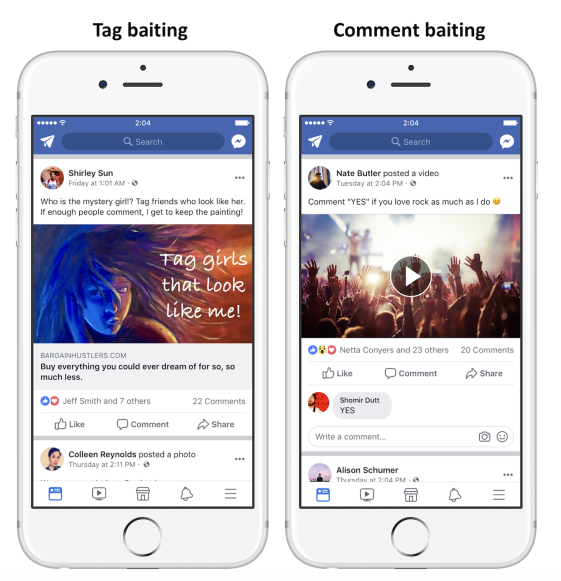
Although there might still be a time and place for these types of posts, brands should strive to start conversations with customers without being shameless about it. Facebook wants us to create content that drives discussion, granted we find creative ways to make it happen.
For example, you can poll your audience while letting them lead the way in terms of discussion. This playful question-based post from Loot Crate scored plenty of love in the form of comments and shares:
Yondu with the WIN! 💙☂️ (Via: Tumblr) Who is the funniest character in the MCU? Learn more about Loot Crate Presents Marvel Gear & Goods : loot.cr/getmarvel
Posted by Loot Crate on Monday, May 27, 2019
In fact, tacking on questions to any given post is a smart way to encourage comments without having to beg for them. Check out how Milk Makeup uses a simple question in one of its posts as a sort of call-to-action:
Brands should also try to post content that’s worthy of debate when appropriate. Controversial content can do just that, although brands should tread lightly as not to run the risk of offending or alienating the audience (think: overtly politically charged or “shock” content).
A recent study from Sprout Social found that if your audience disagrees with your stance on social and political issues, they’ll be less likely to buy from you or recommend your brand to others.
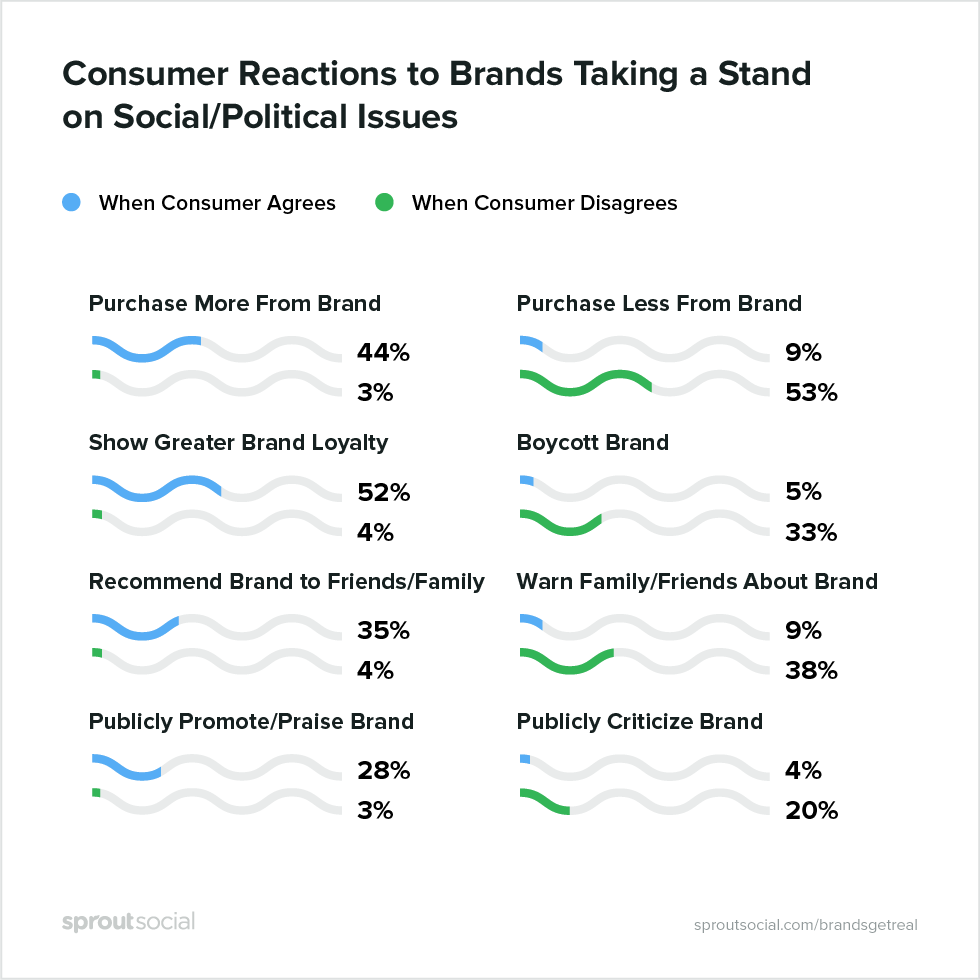
Consider brands such as Delish that regularly post buzzworthy recipes and articles that drive a ton of discussion and shares without ruffling any feathers. These types of off-the-wall posts are perfect for getting a response out of followers.

The more you’re able to get people talking, the more likely the Facebook algorithm is to feature your content organically.
3. Encourage employees and brand advocates to push your content
The key to overcoming the Facebook algorithm has been under your nose since the day you started marketing on the platform. Yet so many brands overlook it—your employees.
Employee advocacy has never been more relevant than it is today. Since Facebook is prioritizing content from friends and family over businesses, this is the perfect time to start your employee advocacy program or rev it up if you already have one.
Your Facebook page’s reach is already somewhat limited by the number of fans/followers you have. And when you tack on these new changes to the algorithm, the number of people that see your content is going to be reduced even more.
Encouraging your team to share your content with their networks on Facebook instantly amplifies your reach. Not only that, but since the posts are coming from friends and family instead of your brand, people will be 16 times more likely to actually read it.
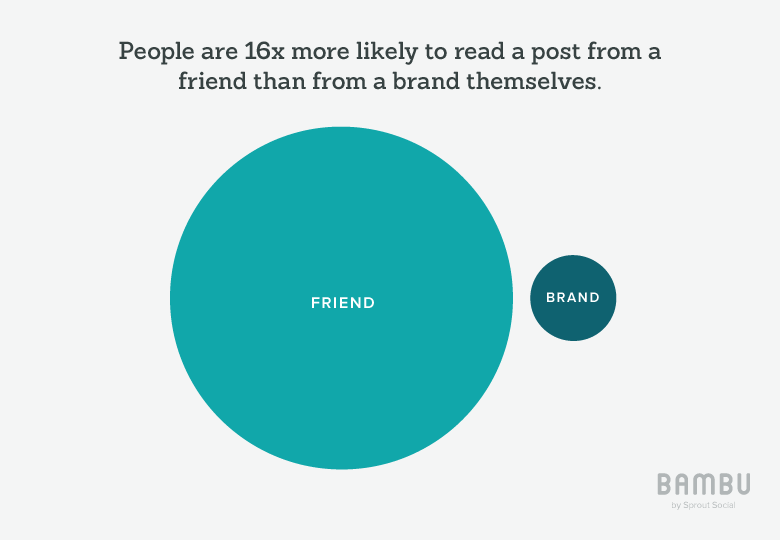
Even if your brand has significantly more followers than your employees, when you consider there are more of them, and they get higher engagement, it’s easy to see the value.
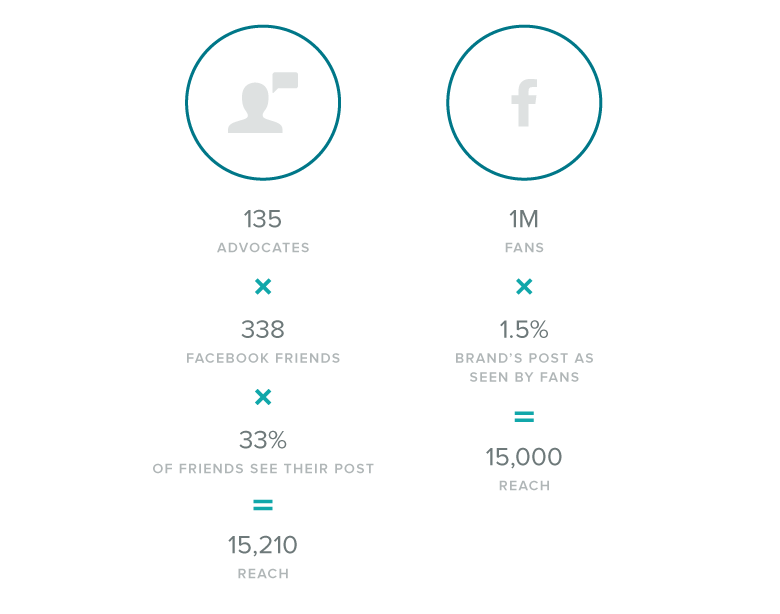
The challenge is getting employees to share your content. Often times, just sending an email asking people to share an article from your company isn’t enough. It requires too much time and effort on their end to go to Facebook, type up a message and share it. Plus, some employees will just flat out forget to share and never check the email again.
That’s why having an employee advocacy platform like Bambu comes in handy.
Bambu makes is very easy to curate content for your employees to share on their personal Facebook page. You can give background info as to what the content is about and provide suggested messaging to include in their post.
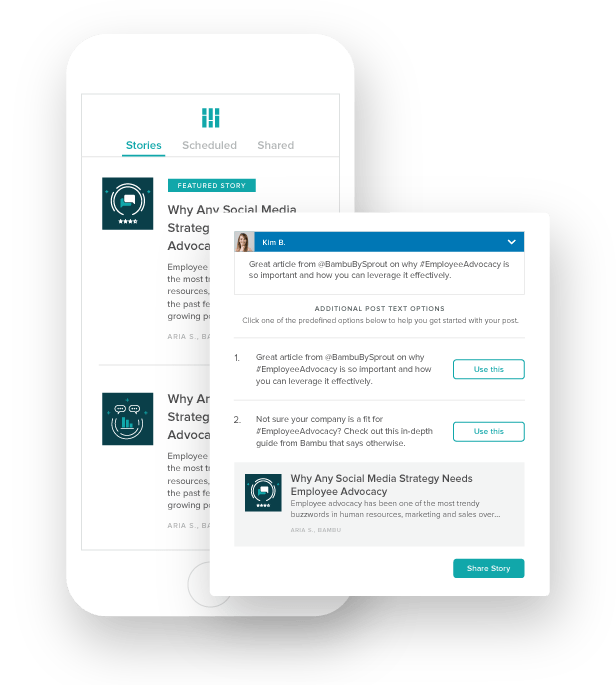
Plus, every time employees login, they’ll see a stream of recommended content to share, which allows them to post on their own time.

Interested in learning more about how to use Facebook’s algorithm to strengthen brand engagement and employee advocacy? Register for our free webinar here.
4. Prioritize photos and tags over external links
Conventional wisdom tells us that Facebook prefers brands to keep content on their platform versus solely linking off-site.
In fact, Facebook’s practice of deemphasizing links and preferring their own native content is no secret, especially in the case of video.
Sure, you’re not going to totally disappear from your followers’ feeds by posting links. That said, keep your feed fresh with different types of content. Blasting external link after external link is not only poor form from a marketing perspective, but also won’t do you any favors with the latest Facebook algorithm.
For example, visual content goes hand in hand with Facebook’s best practices by garnering 87% more engagement. That’s why each and every post should be accompanied by some sort of visual, be it an infographic, .gif or an otherwise eye-popping image.
‘Tale of the tape’ by #RedbubbleArtist jamesbernabe 🎧 What was the first music album you ever purchased?Find the colorful illustration at rdbl.co/2M9evmo✌️
Posted by Redbubble on Wednesday, May 29, 2019
You also have the option of beefing up your descriptions via hashtags or shouting out another page, both of which can expand your reach even further.
Again, your end-game is to encourage engagement. Links by themselves don’t exactly scream “look at me,” do they?
5. Make each post unique to Facebook
As brands are expected to consistently post to Facebook day after day, it’s common for businesses to run out of their own content to promote.
This ultimately results in brands repeating themselves by posting the same pieces over and over or not getting enough mileage out of their content by only posting once.
The solution?
For starters, consider crafting unique descriptions for your posts in order to reintroduce them to your followers without becoming repetitive. Where you might have used a quote the first time, you could switch things up with a tag or question the second or third time.

Another strategy for reintroducing older pieces to your feed without repeating yourself is repurposing content.
There are tons of Facebook tools out there that can help you transform your pieces into something totally new in no time flat.
For example, you can turn a quote from an article into a custom graphic using Canva or Adobe Spark. You could likewise repurpose a blog post into a video using Lumen5 or Animoto.
Oh, and with social scheduling through Sprout, you can create a custom content calendar that helps you keep track of which types of content you’re posting to Facebook, too.

6. Start conversations in Facebook Groups
The reported drop in Facebook page reach, with some sources citing organic reach as low as 2% in 2018, is arguably the algorithm’s biggest blow to marketers.
Does this mean you should totally give up on your brand’s Facebook page?
Absolutely not, but it does explain why many marketers are migrating toward Facebook Groups instead. As fans and followers essentially “opt-in” to a group and commit to discussions within it when they join. In a sense, customers who join your group are arguably the most likely to engage with your brand’s content.
For marketers focused on problem-solving and educating communities, Groups might be better suited to your strengths rather than starting a Page from scratch.
7. Narrow down your audience targeting
The beauty of Facebook is the ability to zero in on your audience.
If you have a widespread audience, consider narrowing your audience down by interests or geography. Facebook (and Sprout) gives you the option to set these preferences and restrictions per post. While this may initially narrow your reach, it may increase your engagement as a result. Think of it as fine tuning the relevance to specific fans.

A good use case of this is if you’re a national company that hosts events across multiple cities. Those in Cincinnati might not care that you’re hosting an event in Miami.
Restricting the audience solely to Cincinnati fans means that you only serve the post to those people who’d actually attend. This increases the likelihood of higher engagement on those posts.
8. Time your Facebook posts to perfection
The Facebook algorithm prioritizes posts that receive engagement, which is why timing your posts is so important.
To maximize engagement, brands should strive to stick to a content calendar that taps into the best times to post on social media.

While such data isn’t the be-all, end-all of when to post, it does shed light on when audiences are typically the most active. Anything you can do to boost your chances of being seen by more followers is a plus, after all.
And by the way, Sprout allows you to schedule your Facebook posts based on when they’re more likely to win the most engagement. This results in less second-guessing the “when” of your post while also encouraging those ever-so-important interactions.
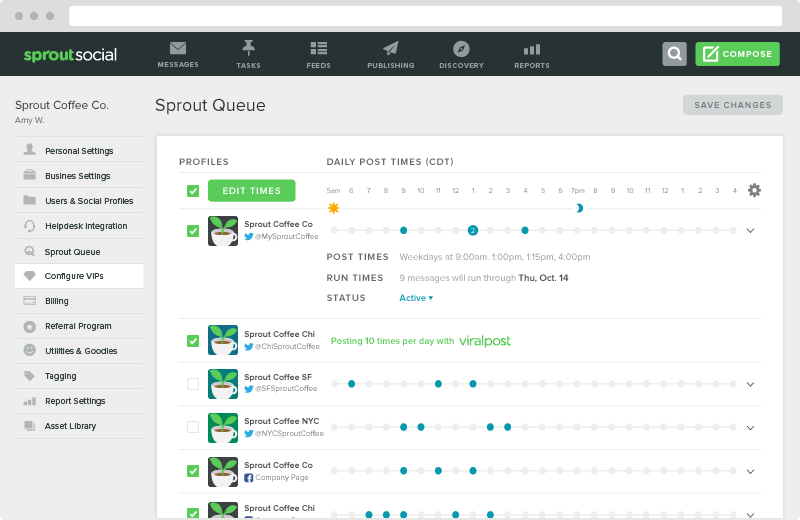
9. Invest in paid promotion on Facebook
While brands should certainly focus on improving their organic reach, there’s no denying the power of Facebook ads.
The good news?
Data shows us that Facebook ads produce an overwhelmingly positive ROI with 93% of marketers already on board. Laser-targeting combined with so many creative options, Facebook ads offer marketers freedom unlike any other ad platform.
Double-dipping some of the tips above, you can create a video ad that grabs the attention of your followers.

Of course, there are also collection and carousel ads which Facebook notes perform extremely well and boast a low CPC.

Coupling your organic efforts with Facebook ads can give you the best of both worlds. The writing has been on the wall for brands to embrace Facebook as a “pay to play” platform, so experimenting with ads now is a sound idea for the long-term.
If you’re totally new to paid promotion on Facebook, you can learn more from our guide to coming up with a Facebook advertising strategy. Features like Sprout’s paid performance report can break down your paid and organic campaigns to better determine your ROI.
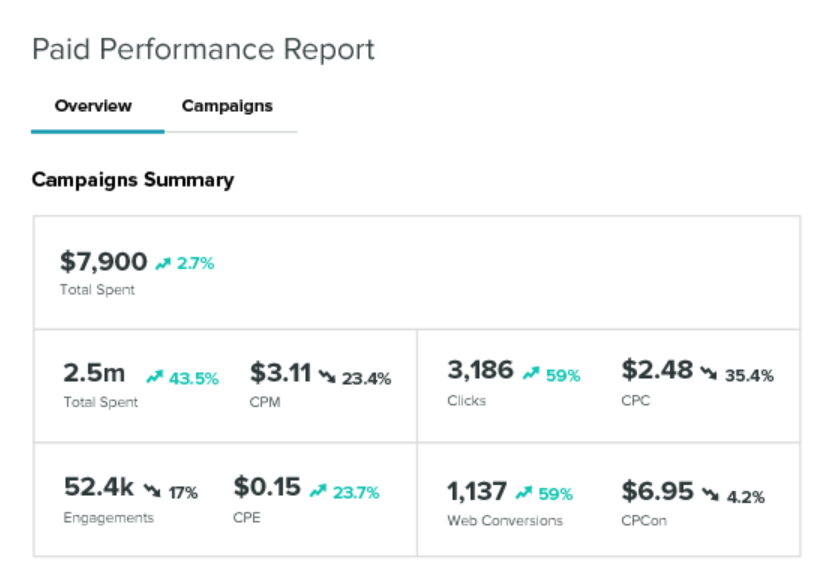
And with that, we wrap up our list!
How do you feel about the new Facebook algorithm?
Like it or not, the ever-changing Facebook algorithm requires brands to rethink their content strategies.
This rings true now and will likely ring true months down the line. Adapting to these sorts of changes is the nature of social marketing as a whole.
And marketers who stay in line with Facebook’s best practices are more likely to be rewarded with reach.
Be honest, though: how do you feel about Facebook’s latest algorithm changes? Confused? Hopeful? Let us know in the comments below!